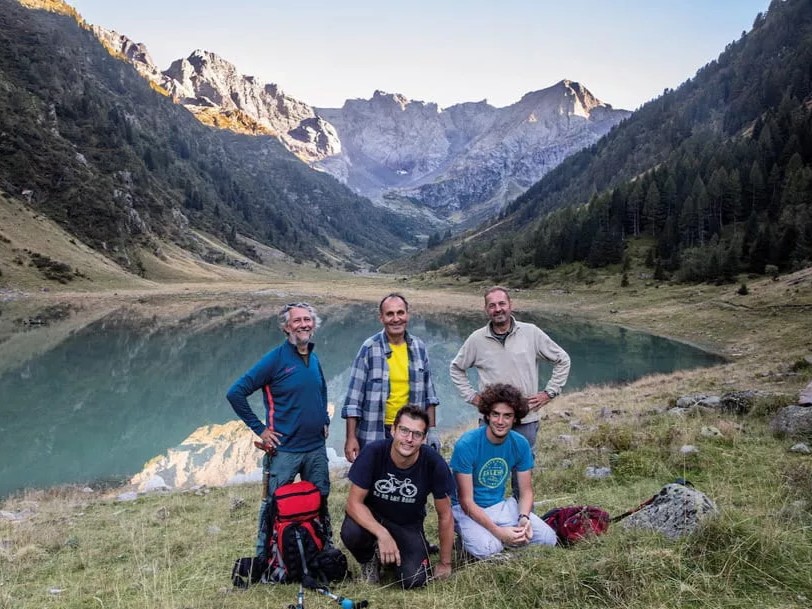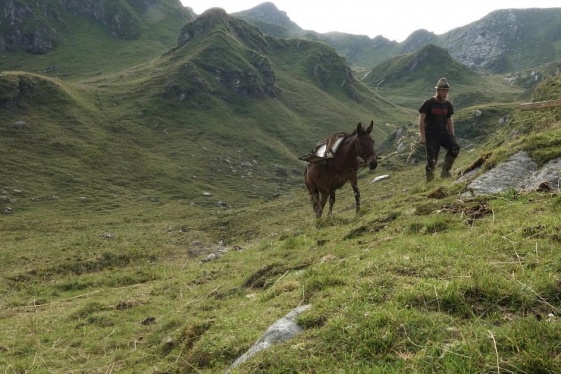

Footprints of amphibians and reptiles, but also plants, seeds, skin imprints and even raindrops: it's a real fossilized ecosystem on very fine-grained sandstone slabs that has been discovered in the Orobie Valtellinesi Park in the province of Sondrio, Lombardy. The find, unearthed by melting snow and ice caused by climate change on Alpine peaks, preserves traces of life dating back 280 million years.
There are wafer-thin fingerprints, trails of long supple tails, ripples of waves on the shores of ancient lakes, and even raindrops that fell on mud before it turned to stone. The first finds, recovered a few days ago at an altitude of 3,000 meters in a spectacular helicopter-supported operation, were shown for the first time at the Museum of Natural History in Milan.
The discovery was made by hiker Claudia Steffensen while hiking a trail in the Ambria Valley at an elevation of 1,700 meters. Steffensen tells her photographer friend Elio Della Ferrera, who takes some photos and sends them to paleontologist Cristiano Dal Sasso of the Museum of Natural History in Milan, who contacts two fellow specialists with whom he initiates work, geologist Ausonio Ronchi of the University of Pavia andichnologist Lorenzo Marchetti of the Museum of Natural History in Berlin. They are the ones who inform the Orobie Valtellinesi Park and the Superintendence of the find. The surveys started in the summer of 2023, and the researchers photographed and mapped hundreds of fossil traces that surfaced at nearly 3,000 meters above sea level on the vertical walls of Pizzo del Diavolo di Tenda, Pizzo dell'Omo, and Pizzo Rondenino, but also on the accumulations of the landslides below.
Experts recognized footprints of tetrapods (reptiles and amphibians) and invertebrates (insects, arthropods), often still lined up to form 'tracks,' or walks that occurred in the Permian, the last period of the Paleozoic Era.
“Dinosaurs did not yet exist at that time, but the authors of the largest footprints found here must have been of considerable size anyway: up to 2-3 meters in length,” Dal Sasso explains. In addition, at this new site, footprints of at least five different species of animals are fossilized on some surfaces (since these are tracks and not skeletons, it is more correct to speak of icnospecies), which will allow accurate paleoecological reconstructions to be made.
“The footprints were imprinted when these sandstones and mudstones were still waterlogged sands and muds, at the margins of rivers and lakes that periodically, according to the seasons, dried up,” Ronchi points out. “The summer sun, drying those surfaces, hardened them to such an extent that the return of new water did not erase the footprints but, rather, covered them with new clay, forming a protective layer.”
“The very fine grain of the sediments, now petrified, allowed the preservation of sometimes impressive details, such as the fingerprints of the fingertips and belly skin of some animals,” Marchetti adds. “Shape and size of the traces indicate a remarkable quality of preservation and paleo-biodiversity, probably even higher than that observed in other deposits of the same geological age in the areas ce today belonging to the provinces of Bergamo and Brescia.”
SOURCE: La Repubblica
You may be interested
-
Il Console Generale Usa: su turismo e seta s...
In mattinata ha incontrato il sindaco di Como, Mario Lucini, assieme all'assessore Gisella...
-
Small and Medium Enterprises as the Italian...
by Claudia Astarita A recent study on 120 artisan SMEs of excellence – conducted...
-
The Italian Heritage Society of Indiana Lect...
Sunday, November 23 - 2 pmWhen: Sunday, November 23, 2014 2:00-4:00 pm Where: UL 1126 in t...
-
'Freedom Fighters', i Kennedy e la lotta per...
John F. Kennedy, Robert F. Kennedy, Martin Luther King. Tre figure iconiche di quel moment...
-
'I visited an idyllic Italian town that's a r...
If you're itching for a holiday in a warm, sunny and relaxing location that also offers pl...
-
'It's not a job, it's a disease': Italy's reb...
“I feel much more comfortable here under the rain, wet and cold than in an apartment in th...
-
'Mechanic' of music Da Vinci's organ reconstr...
No one had ever heard its "voice" before: a warm, ancient sound similar to that of a flute...
-
'They were never alone': In Italy's darkest h...
International charity workers are breathing a sigh of relief as they pack up a field hospi...













